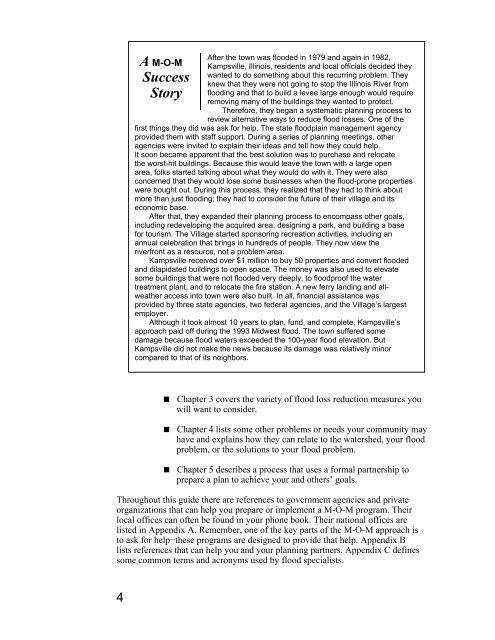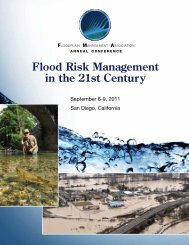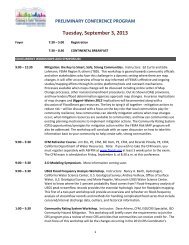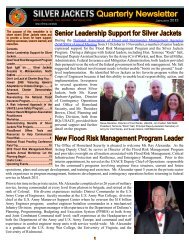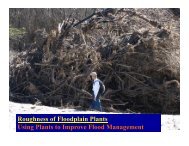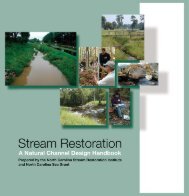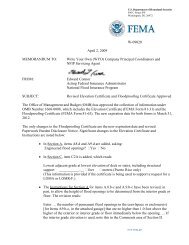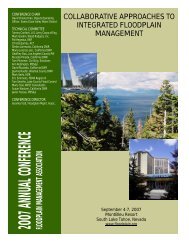Using Multi-Objective Management to Reduce Flood Losses in Your
Using Multi-Objective Management to Reduce Flood Losses in Your
Using Multi-Objective Management to Reduce Flood Losses in Your
You also want an ePaper? Increase the reach of your titles
YUMPU automatically turns print PDFs into web optimized ePapers that Google loves.
A M-O-M<br />
Success<br />
S<strong>to</strong>ry<br />
After the <strong>to</strong>wn was flooded <strong>in</strong> 1979 and aga<strong>in</strong> <strong>in</strong> 1982,<br />
Kampsville, Ill<strong>in</strong>ois, residents and local officials decided they<br />
wanted <strong>to</strong> do someth<strong>in</strong>g about this recurr<strong>in</strong>g problem. They<br />
knew that they were not go<strong>in</strong>g <strong>to</strong> s<strong>to</strong>p the Ill<strong>in</strong>ois River from<br />
flood<strong>in</strong>g and that <strong>to</strong> build a levee large enough would require<br />
remov<strong>in</strong>g many of the build<strong>in</strong>gs they wanted <strong>to</strong> protect.<br />
Therefore, they began a systematic plann<strong>in</strong>g process <strong>to</strong><br />
review alternative ways <strong>to</strong> reduce flood losses. One of the<br />
first th<strong>in</strong>gs they did was ask for help. The state floodpla<strong>in</strong> management agency<br />
provided them with staff support. Dur<strong>in</strong>g a series of plann<strong>in</strong>g meet<strong>in</strong>gs, other<br />
agencies were <strong>in</strong>vited <strong>to</strong> expla<strong>in</strong> their ideas and tell how they could help.<br />
It soon became apparent that the best solution was <strong>to</strong> purchase and relocate<br />
the worst-hit build<strong>in</strong>gs. Because this would leave the <strong>to</strong>wn with a large open<br />
area, folks started talk<strong>in</strong>g about what they would do with it. They were also<br />
concerned that they would lose some bus<strong>in</strong>esses when the flood-prone properties<br />
were bought out. Dur<strong>in</strong>g this process, they realized that they had <strong>to</strong> th<strong>in</strong>k about<br />
more than just flood<strong>in</strong>g; they had <strong>to</strong> consider the future of their village and its<br />
economic base.<br />
After that, they expanded their plann<strong>in</strong>g process <strong>to</strong> encompass other goals,<br />
<strong>in</strong>clud<strong>in</strong>g redevelop<strong>in</strong>g the acquired area, design<strong>in</strong>g a park, and build<strong>in</strong>g a base<br />
for <strong>to</strong>urism. The Village started sponsor<strong>in</strong>g recreation activities, <strong>in</strong>clud<strong>in</strong>g an<br />
annual celebration that br<strong>in</strong>gs <strong>in</strong> hundreds of people. They now view the<br />
riverfront as a resource, not a problem area.<br />
Kampsville received over $1 million <strong>to</strong> buy 50 properties and convert flooded<br />
and dilapidated build<strong>in</strong>gs <strong>to</strong> open space. The money was also used <strong>to</strong> elevate<br />
some build<strong>in</strong>gs that were not flooded very deeply, <strong>to</strong> floodproof the water<br />
treatment plant, and <strong>to</strong> relocate the fire station. A new ferry land<strong>in</strong>g and allweather<br />
access <strong>in</strong><strong>to</strong> <strong>to</strong>wn were also built. In all, f<strong>in</strong>ancial assistance was<br />
provided by three state agencies, two federal agencies, and the Village’s largest<br />
employer.<br />
Although it <strong>to</strong>ok almost 10 years <strong>to</strong> plan, fund, and complete, Kampsville’s<br />
approach paid off dur<strong>in</strong>g the 1993 Midwest flood. The <strong>to</strong>wn suffered some<br />
damage because flood waters exceeded the 100-year flood elevation. But<br />
Kampsville did not make the news because its damage was relatively m<strong>in</strong>or<br />
compared <strong>to</strong> that of its neighbors.<br />
Chapter 3 covers the variety of flood loss reduction measures you<br />
will want <strong>to</strong> consider.<br />
Chapter 4 lists some other problems or needs your community may<br />
have and expla<strong>in</strong>s how they can relate <strong>to</strong> the watershed, your flood<br />
problem, or the solutions <strong>to</strong> your flood problem.<br />
Chapter 5 describes a process that uses a formal partnership <strong>to</strong><br />
prepare a plan <strong>to</strong> achieve your and others’ goals.<br />
Throughout this guide there are references <strong>to</strong> government agencies and private<br />
organizations that can help you prepare or implement a M-O-M program. Their<br />
local offices can often be found <strong>in</strong> your phone book. Their national offices are<br />
listed <strong>in</strong> Appendix A. Remember, one of the key parts of the M-O-M approach is<br />
<strong>to</strong> ask for help−these programs are designed <strong>to</strong> provide that help. Appendix B<br />
lists references that can help you and your plann<strong>in</strong>g partners. Appendix C def<strong>in</strong>es<br />
some common terms and acronyms used by flood specialists.<br />
4


